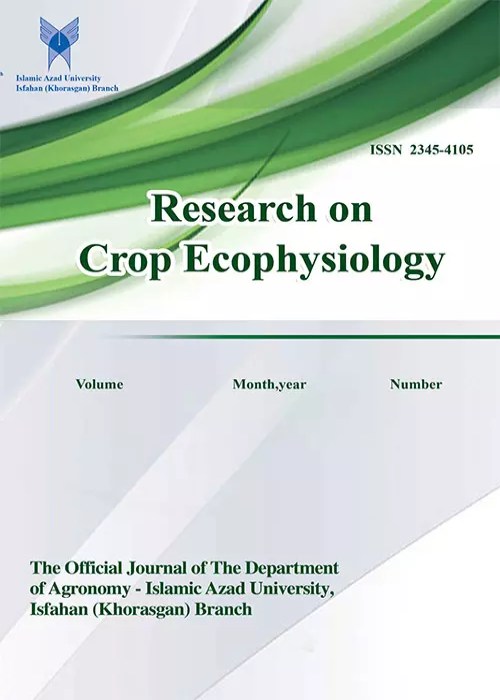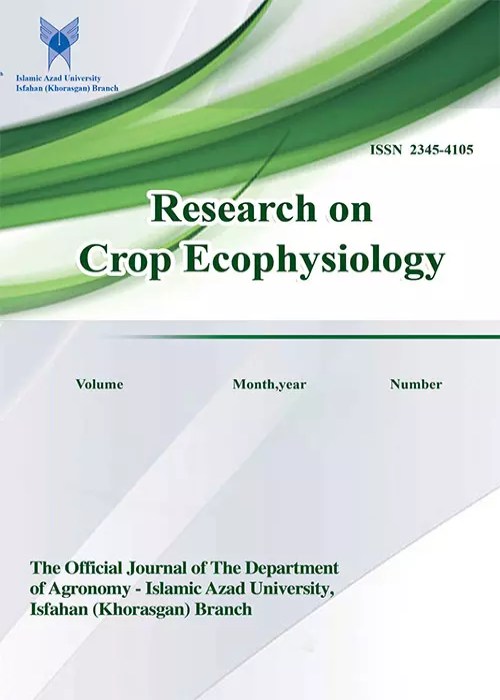فهرست مطالب

Journal of Research on Crop Ecophysiology
Volume:17 Issue: 1, Winter 2022
- تاریخ انتشار: 1402/08/15
- تعداد عناوین: 6
-
Pages 1-11
Sorghum is an excellent alternative forage to corn silage in unfavorable environmental conditions. In order to evaluate eight sorghum cultivars and one corn cultivar (S.C 704 as control) under salinity stress (EC: 10.8 ds/m in soil and 5 ds/m in water), a randomized complete block design with three replicates was used during 2017-2018 cropping season at Fajr Isfahan Agricultural and Livestock CO. research field. Seven morphological traits, forage yield, and dry matter (DM) were determined and 15 traits related to silage were measured after ensiling in a plastic cylinder. The results showed that the Hannibal and Pegah cultivars had the highest forage yield with an average yield of 56.9 and 53.4 tons/h, respectively, whereas corn had the lowest forage yield with an average of 20.5 tons/h under test conditions. Hannibal and Sucrose Photo one BMR cultivars had the highest DM with 26.7% and 26.6%, respectively. Corn silage had the highest amount of crude protein, non-fibrous carbohydrates, total digestible nutrients, digestible energy, metabolizable energy, net energy lactation, crude fat, and the lowest amount of ash, acidity, the insoluble fiber in acid detergent and insoluble fiber in neutral detergent. This is followed by Pegah cultivar with a slight difference. It seems that the Pegah cultivar due to higher fodder yield, same silage quality as corn, more tolerance to drought, salinity, and heat than corn, and considerably less water requirement is a suitable alternative for corn in many salinity and water-scarce regions of Iran.
Keywords: Sorghum bicolor L, Abiotic stress resistant, Forage, Silage quality, Digestible nutrients, Improper cultivation conditions -
Pages 13-17
Basil (Ocimum basilicum L.) Lamiaceae is the most important medicinal plants. Much of the essential oils of basil essential oil phenylpropanoids which 90% are included. Important phenylpropanoid compounds include. The experiment was done in a randomized complete block design (RCBD) with factorial arrangements with 3 levels of UV-C Radiation (1/5- 4/5- 10 KJ M-2S-1) and Changes in Antioxidant activity and phenolic compounds were evaluated during five different stages. The amount of Antioxidant activity the gene expression was not affected by ultraviolet radiation treatment, and the expression level increased in control samples compared to other samples Furthermore, phenolic compounds were tested. UV-C treatment at the level of 10 kJ M-2S-1their expression levels increased.
Keywords: Ultraviolet radiation, Antioxidant, phenol, basil -
Pages 19-24
Coriander (Coriandrum sativum) in addition to its wide applications in the food, perfumery and cosmetics industries, has significant medicinal properties. Based on various studies in the field of pharmacognosy, different effects have been reported for coriander. In this review study, the medicinal uses of coriander in the field of neurological and psychological disorders are discussed and the use of coriander essential oil, syrup and its seeds for disorders such as Alzheimer's, anxiety, migraine, and seizures are reviewed.
Keywords: Coriander, Neuropsychological diseases, Alzheimer's Disease, anti-anxiety -
Pages 26-44The Effect of Magnetic Field Intensity and Duration on the Amount of Nutrients Absorbed by Cucumber Transplant
Moradali Ghanbarpouri1, Ahmad Mohamadi Ghahsareh*2, Mitra Attaabadi3, Mehran Hodaji4
PhD candidate, Department of Soil Science, Islamic Azad University of Isfahan, Iran
Associate Professor, Department Soil Science, Islamic Azad University of Isfahan, Iran
Assistant Professor, Department of Soil Science, Islamic Azad University of Isfahan, Iran
Professor, Department of Soil Science ,Islamic Azad University of Isfahan, Iran
*Corresponding author Email: [email protected]
Received: 10 October 2021 Accepted: 8 January 2022
Abstract
Over many years, the effects of magnetic fields on plant life have been the subject of different research studies. Recently, many authors have reported the effects of magnetic fields on the metabolism and growth of different plant species. In this study, in order to evaluate the effect of intensity and duration of magnetic field on nutrient uptake in cucumber transplant, cucumber seeds were treated with different values of magnetic field intensity and duration. The four levels of magnetic field intensity (0-80-140 and 240mT) and time exposure to the magnetic field were 5, 10, 15 and 20 minutes. After growth of seedlings after 5 leaf foliage, the chemical elements including manganese, zinc, copper, phosphorus, potassium, magnesium and total nitrogen were analyzed. The results showed that the concentration of Mn, Zn, Cu, K, Ca, Mg and N increased, while P and Fe decreased with increasing magnetic field intensity and duration of magnetic field exposure. The results show that iron, zinc, copper, phosphorus and potassium had the highest adsorption at 80 mT and 10 and 15 min, respectively. But phosphorus and potassium at 80mT for 15 and 5 minutes had the most effect on the absorption of these two elements, which increased with increasing magnetic field intensity. Calcium and nitrogen had the highest adsorption at 240 mM and 5 and 20 min, respectively. But the intensity and duration of the magnetic field had no effect on the absorption of magnesium in the transplant of cucumber.Keywords: Cucumber Transplant, Magnetic Field Intensity, Nutrients Absorption -
Pages 46-63Evaluation of Morphological Traits in Some Castor Plant Genotypes in Isfahan Climate Condition
Shahla Etebarian1, Hossein Ali Asadi-Gharneh 2*
Department of Horticulture, College of Agriculture, Isfahan (Khorasgan) Branch, Islamic Azad University, Isfahan, Iran
Department of Horticulture, College of Agriculture, Isfahan (Khorasgan) Branch, Islamic Azad University, Isfahan, Iran
*Corresponding Author Email Address: [email protected]
Received: 21 September 2021 Accepted: 8 January 2022
Abstract
Castor plant with the scientific name Ricinus communis L. is one of the oil plants of the Euphorbiaceae family cultivated in many parts of Iran. Castor plant is one of the important medicinal plants used in the cosmetic, health and pharmaceutical industries. Its medicinal properties are associated with the presence of phytochemical compounds such as alkaloids, flavonoids and tannins. The purpose of this study is to study the morphological characteristics of 15 different genotypes of castor bean plants under the climatic conditions of Isfahan province. This research was conducted in the form of a randomized complete block design and three replications in the research farm of Islamic Azad University, Isfahan (Khorasgan) Branch in the year 1400-1401, located in eastern Isfahan, Khatunabad. Average comparisons between the investigated genotypes showed that the Isfahan genotype had the lowest number of clusters and the highest plant height and stem length. Jiroft and Malair genotypes had the highest number of clusters with 5 and 4 clusters, respectively. Jiroft, Fars and Mashhad genotypes had a capsule size of 2.6 cm. Mashhad, Shahrekord and Zahedan genotypes had the highest number of leaves with 34, 33 and 29 respectively, and Mashhad and Shahrekord genotypes had the highest and lowest weight per thousand seeds with 524.61 grams and 132.72 grams, respectively. Mashhad and Jiroft genotypes had 23 and 21 sub-branches, respectively. In addition, the Shahrekord genotype was the lowest with a seed width of 6.89 mm. Jiroft and Shahrekord genotypes had the highest and lowest stem cross-sectional areas with 3 cm2 and 1.3 cm2, respectively. In general, there is considerable genetic diversity between castor plant genotypes in terms of morphological characteristics. High yields of 1,000 seed weight, capsule size and cross-section are available to the food and pharmaceutical industries by growing Mashhad, Fars and Jiroft genotypes in Isfahan.Keywords: Castor, genotype, Morphological Characteristics, climate, 1000 seed weight -
Pages 64-74Flow and Effects of Phosphorus From Soil to Plant
Heydar Naeim Delfi1, Mohammad Mirzaei Heydari2*
Department of Production Engineering and Plant Genetics, Isfahan (Khorasgan) Branch, Islamic Azad University, Isfahan, Iran.
2-Associate Professor, Department of Production Engineering and Plant Genetics, Isfahan (Khorasgan) Branch, Islamic Azad University, Isfahan, Iran.
*Corresponding Author Email Address: [email protected]
Received: 11 August 2021 Accepted: 8 November 2022
Abstract
Phosphorus (P) is considered a large and important nutrient element, and it is generally concentrated in the surface soil layers, and the absorption of phosphorous by plant roots depends on the moisture content around the roots and the nature and shape of the morphological roots, as the structure of the roots plays a significant role in maximizing the absorption of phosphorus, and its presence is affected In the soil form according to climatic conditions, acidity and alkalinity of the soil, and phosphorus plays many important roles in plants, as it is considered an necessary element in deoxyribonucleic acid RNA and DNA, Which contain the genetic code responsible for the production of proteins, enzymes, phospholipids, membranes, oxidation-reduction reactions, glycolysis, respiration, and other compounds necessary for plant structure, phosphorus is often subjected to sequestration, precipitation, adsorption, and coatings such as phosphorus paint with carbon minerals, which changes rapidly, and it turns into difficult compounds that are not available to plants, matching the types of fertilizers containing phosphorus with the physical and chemical properties of the soil is an effective strategy for the effective and rational use of phosphorous fertilizers, but the dynamics of phosphorus remains dependent on the nature of the morphological and physiological roots as well as the soil structure and the amount of phosphorus.Keywords: Phosphorus dynamics, Root morphology, soil, Rhizosphere


